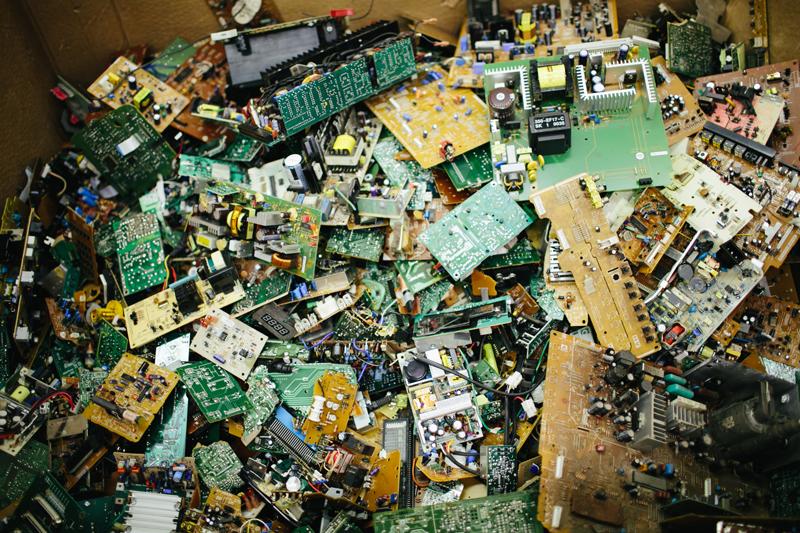Look up this fun fact on your smartphone: There’s about 100 times more gold in a ton of mobile phones than in a ton of gold ore, according to the World Economic Forum. There’s also lithium, rare earth elements, silver, copper, platinum, palladium, cobalt and more. Much more.
Above ground or below, ores and metals are a finite resource. Recent studies published by the Royal Society of Chemistry indicate that traditional supplies of many mineral elements that are vital for low-carbon technologies (electric vehicles, batteries, wind turbines, solar panels, etc.) will be consumed in less than 50 years if we continue the current extraction and consumption rates. At the same time, new legislation and growing social pressure to mitigate climate change are driving demands for even more of these technologies.
One way to balance these supply and demand challenges may be mining electronic waste resources. In addition to smart phones, e-waste includes 3-D printers, medical devices, spent solar panels and old electric car batteries. Compared to mining virgin ores, it is more energy efficient, reduces carbon emissions and there’s money to be made. A study published in 2019 estimates that the raw materials in electronic waste were worth roughly $57 billion (United Nations University, International Telecommunication Union, and International Solid Waste Association). The study also indicated that 53.6 million metric tons of e-waste are generated each year globally, of which only about 17 percent is formally recycled.
In the U.S. a small percentage of recycled electronics are simply dismantled into component parts and the materials are sent to other countries for refining and reuse, according to the Minnesota Pollution Control Agency. And that global 83 percent that isn’t recycled? There’s little data, except that it predominantly ends up in landfills.
E-waste contains metals critical to high-tech products including cobalt, lithium, rare earths, gallium, germanium, tantalum, tungsten, platinum and palladium. It also contains valuable bulky materials such as copper, iron, and aluminum, along with plastics, ceramics, fillers and glass. And while it’s true that recycling rates for copper, iron and aluminum are high – more than 50 percent – recycling rates for 35 critical elements is below one percent. And plastics recycling? Zero to 20 percent.
The potential in e-waste recycling is huge, but so are the challenges.
Exploring the Horizon

NRRI Engineer Shashi Rao prepared an internal summary report in 2021 as an initial step to outline the innovation gaps that NRRI may be able to help address. In preparing the report, he conducted “voice of customer” interviews from across the metals recycling industry during the first half of 2020. The data cited were published in 2019 and 2020.
NRRI is now considering updating the report and identifying projects to address the barriers and opportunities associated with accessing the value in electronic waste.
"NRRI is always exploring new opportunities to sustainably meet Minnesota's resource needs," said Matt Mlinar, NRRI Interim Mineral Processing & Metallurgy Research Group Manager. "This report generated some interesting internal discussions and we're hoping to extend the conversation and find partners in this arena."
The report highlights key issues related to plastics and metal recovery from end-of-life electronic and electrical equipment, and challenges in creating circular supply chains for these materials. It also identifies opportunities to improve the recycling rates of "difficult to recycle" materials and creating secondary markets for electronic waste materials. Rao also outlines opportunities to define recycling methods for newer materials that are introduced into new electronic gadgets.
Research Opportunities
Research opportunities with high potential for significant impact, and that fit in the University of Minnesota research enterprise, include:
- Develop techniques to upscale e-waste plastics into higher value-added products.
- Develop characterization techniques to measure recycled plastic content in newer electronic products.
- Develop super-polymers that have superior functionality and recyclability compared to today’s polymers.
- Develop recycling methods for next generation EV and energy storage batteries (solid-state and lithium-iron-phosphate batteries); along with methods to characterize waste battery materials.
- Develop multiple avenues to improve the recyclability of wind turbine and solar panel components.
- Understand deficiencies of current recycling technologies to recover materials from future electronic products.
- Investigate how complex products can be dismantled so that relevant components can be channeled into appropriate metallurgical end-processes.
The NRRI report identifies critical research equipment, skillsets, collaborators, and funding opportunities required to support and sustain a regional research facility. Next steps include soliciting feedback from stakeholders, finding funding, identifying partners and obtaining necessary equipment.
“Improving the recyclability of electronics is a win scenario all around,” said Rao. “More research is needed to evaluate the feasibility of a regional program to maintain economic competitiveness and improve Minnesota’s environmental stewardship.”
NRRI focuses on minimizing waste and environmental impact, maximizing value from all resources, and maintaining/restoring ecosystem function. As part of its strategic initiative, NRRI conducted this exploratory project to understand the innovation needs of the electronics waste recycling industry. This effort is an essential step in promoting resource efficiency, improved materials recycling, and life cycle thinking.
